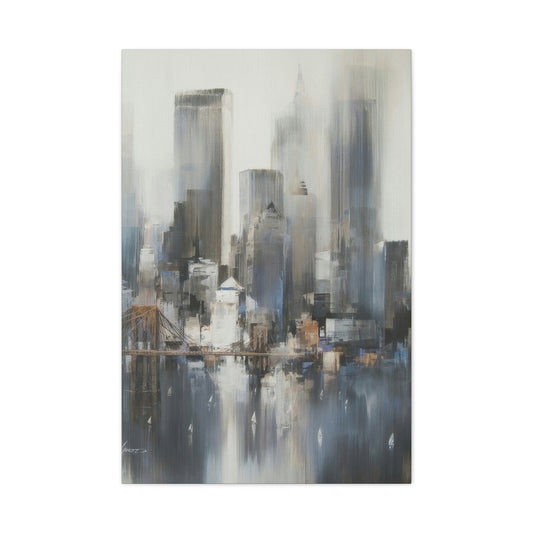A playroom is more than just a corner filled with toys. It’s the creative heart of a home where children laugh, learn, and let their imaginations run wild. Designing such a space means balancing practicality with creativity, and wall décor plays a surprisingly powerful role in making it both functional and inspiring. While furniture and storage keep the room organized, it’s the art on the walls that breathes energy, color, and imagination into the environment.
Why Wall Décor Matters in a Playroom
Children spend countless hours in their playrooms. These are the spaces where they first begin to experiment with independence and exploration. Walls that are plain and bare may feel uninspiring, but when decorated thoughtfully, they can stimulate creativity, encourage learning, and provide a sense of comfort. Artwork is also safer and more practical compared to cluttering the floor with delicate décor pieces, since art can be hung at a height where little hands cannot reach, but little eyes can still enjoy.
Wall décor sets the mood. Bright and bold colors invite energetic play, while softer tones and whimsical illustrations encourage calm and creativity. The right choice of wall art can give the playroom its own identity, separate from other areas of the home, making it a designated sanctuary for fun and exploration.
Custom Wall Art for a Personal Touch
Personalized art carries a special kind of magic in a child’s space. When children see their names, initials, or birth dates proudly displayed in artwork, the playroom becomes more than just a room—it becomes theirs. This sense of ownership is powerful for children, giving them confidence and pride in their environment.
Parents often choose monogram prints, custom illustrations of favorite animals, or even framed artworks inspired by their child’s drawings. Imagine a canvas with a child’s name written in bold letters surrounded by stars, or a soft watercolor piece featuring their birth month flower. These elements add a deeply personal layer of meaning, while still being stylish enough to grow with them as they get older.
The key to successful personalized décor is versatility. While it’s tempting to go overly childish, choosing designs with timeless appeal ensures that the wall art won’t feel outdated as the child grows. A playful font, clean lines, and a balance between fun and sophistication keep the piece relevant for years to come.
Following Trends Without Losing Personality
Trends in children’s décor shift just as quickly as fashion trends, but one that consistently draws attention is bold, colorful wall art. Pop-art-inspired prints, for example, remain popular because they combine vibrant color with eye-catching shapes and subjects. Children are naturally drawn to bold patterns and dynamic compositions, making these pieces ideal for sparking curiosity and conversation.
Animal motifs, cartoonish designs, and fantastical elements like rainbows or rockets can make a playroom instantly lively. The trick is to strike a balance between what is currently popular and what feels timeless. Choosing a few trend-inspired pieces as accents while keeping the larger artwork more neutral ensures that the room stays fresh but won’t require a full makeover when trends fade.
Creating Space Through Smart Décor Choices
While wall art beautifies the room, its placement also affects how spacious the area feels. A common mistake is overloading every inch of wall with frames and canvases, which can make a small playroom feel cramped. Leaving breathing space around each piece allows the room to feel open and inviting.
Interior designers often recommend designating one wall as the primary “gallery” and keeping the others more minimal. For example, a large canvas could serve as a focal point on the main wall, while smaller, complementary prints are scattered across the others. This approach creates visual balance and prevents overstimulation.
In addition, artwork that uses perspective or panoramic layouts can make a small playroom appear larger. A wide canvas with a landscape scene, for instance, creates the illusion of depth, tricking the eye into believing the room is more spacious.
Choosing Shapes That Speak to the Room
One of the most overlooked aspects of playroom wall décor is the shape of the artwork itself. Different canvas layouts create very different moods.
-
Single-panel rectangles and squares are classic, giving a clean, organized look.
-
Vertical panels work well in narrow spaces, making walls look taller.
-
Panoramic canvases emphasize width, which can expand the feeling of a room.
-
Triptychs (three panels) introduce symmetry and balance while keeping the display playful.
-
Multi-panel arrangements such as five-piece or seven-piece sets add dynamism and visual intrigue, perfect for a space meant to encourage imagination.
-
Unique shapes like hexagons or wave-like arrangements give the playroom a distinctly modern and playful vibe.
The choice depends not only on the size of the wall but also on the atmosphere you want to create. A minimalist parent may lean toward one large rectangular print, while another may prefer a gallery-style arrangement of smaller pieces that tells a story across the wall.
Size Matters: Scaling Artwork Correctly
Selecting the right size of wall art is just as important as the design itself. A piece that is too small may look lost on a large wall, while one that is too big may overpower the room. A general guideline is to match the width of the artwork to two-thirds the size of the furniture below it. For instance, if a playroom bench is six feet long, a canvas around four feet wide will feel balanced.
Oversized art is a bold choice but can serve as the defining feature of the playroom. A massive, vibrant print above a toy storage unit can instantly turn the space into a gallery-like experience. On the other hand, multiple smaller prints arranged together can create a flexible, story-like atmosphere, especially when themed (such as animals, alphabets, or outer space).
Stylish Yet Functional Décor Choices
Playroom décor shouldn’t only be decorative; it should also encourage imagination and learning. Educational art is one way to blend beauty with functionality. A large world map in bright colors, alphabet illustrations, or number charts designed as playful graphics can subtly reinforce learning without making the room feel like a classroom.
Art that reflects hobbies and interests also enhances engagement. A child who loves dinosaurs will find joy in a dinosaur-themed wall piece, while another who dreams of space travel may be captivated by an illustrated solar system. By incorporating their passions into the décor, the playroom becomes a reflection of who they are.
Color Palettes That Energize and Soothe
Few elements impact mood as strongly as color. Playrooms are the perfect setting to experiment with bright, cheerful shades that might feel overwhelming elsewhere in the home. From turquoise and lime green to fuchsia and sunshine yellow, the possibilities are endless.
Color psychology suggests that certain hues are particularly effective in children’s spaces:
-
Yellow radiates joy and stimulates creativity.
-
Blue creates a calming backdrop, reducing overstimulation during long play sessions.
-
Green encourages balance and growth, making it ideal for learning corners.
-
Pink and purple often inspire imaginative play and comfort.
The trick is to combine bold accents with softer background tones. A playroom wall painted a soft neutral can be enhanced with bright, colorful artwork, achieving a vibrant yet balanced look.
Pro Tips for Hanging and Displaying Wall Art
Even the most beautiful artwork can feel out of place if hung incorrectly. A few professional tips can make all the difference:
-
Leave at least one foot of space between the edge of the wall and the start of the artwork. Hanging too close to the wall’s edge can make the room look cramped.
-
Position art at eye level for children, not adults. This helps make the space feel like it belongs to them.
-
Mix and match frame styles for a more eclectic, playful feel. Uniform frames create a polished, formal look, but varying textures and colors are more inviting for kids.
-
Use lightweight materials to ensure safety in case a piece ever falls. Canvas prints or foam-board art are lighter alternatives to heavy glass frames.
Bringing It All Together
The beauty of playroom wall décor lies in its flexibility. Unlike furniture, which is often expensive and cumbersome to replace, wall art is adaptable and easy to update. This means parents can refresh the look of the playroom every few years to match their child’s evolving interests and developmental stage.
By combining personalization, playful trends, thoughtful scaling, educational value, and vibrant color palettes, you can create a playroom that is not only visually appealing but also deeply meaningful. Every glance at the walls can spark joy, curiosity, or imagination—exactly what a child’s play space should be.
Every playroom tells a story. While toys bring in a rotating cast of characters, the walls provide a constant backdrop that shapes the mood of the entire space. A thoughtfully decorated wall can spark imagination, provide comfort, or even encourage learning in subtle ways. Unlike furniture or toys that wear out or get replaced, wall décor can remain timeless, evolving as children grow while still maintaining its playful spirit.
The Role of Themes in a Playroom
Themes give direction to décor choices. Without a theme, walls can end up feeling random or cluttered, but with a guiding idea, every piece works together to create harmony. A theme doesn’t have to be elaborate—it could be as simple as “nature-inspired,” “colorful geometry,” or “storybook worlds.”
The beauty of a theme is that it adapts as children grow. A toddler might adore oversized alphabet prints and animal silhouettes, while an older child might want artwork of cityscapes or abstract patterns. The core theme—whether educational, adventurous, or whimsical—remains, but the execution matures with the child.
Popular Themes for Playroom Walls
1. Nature and the Outdoors
Children are naturally curious about the world around them, and nature-inspired décor is a timeless choice. Wall art featuring forests, mountains, oceans, or animals helps bring a sense of adventure indoors. Soft watercolor trees can create a calming forest backdrop, while bold safari-inspired art adds a sense of exploration.
Floral or botanical prints are also popular, especially when combined with natural colors like greens, blues, and earthy neutrals. These designs provide a gentle reminder of the outdoors, which is especially valuable for families living in urban spaces with limited direct access to nature.
2. Space and Science
From rockets and astronauts to planets and galaxies, space-inspired décor never loses its charm. Children of all ages are fascinated by the mysteries of the universe. Wall murals or canvases featuring the solar system, shooting stars, or whimsical interpretations of outer space can fuel endless curiosity.
Science-themed wall art isn’t limited to astronomy. Microscopic patterns, geometric shapes, or stylized interpretations of chemical elements can also create visually engaging and educational displays. For older children, abstract representations of molecules or constellations offer a cool, modern look that doubles as a learning tool.
3. Fairy Tales and Fantasy
Playrooms are often where fairy tales come alive. Castles, dragons, unicorns, and enchanted forests make perfect motifs for storytelling-inspired walls. Fantasy themes are especially effective because they tie into imaginative play, encouraging children to invent their own narratives.
Whimsical line drawings, dreamy pastel colors, and sparkly accents can bring these worlds to life. Even a single oversized print of a magical creature can set the tone for the entire space.
4. Travel and Adventure
World maps, hot air balloons, vintage cars, or stylized landmarks like the Eiffel Tower or the Great Wall of China can inspire a sense of curiosity about the world. This theme is versatile—it can be playful for younger children or more sophisticated for preteens.
Travel-inspired art also offers subtle educational benefits. Kids begin to recognize continents, oceans, and cultural diversity through visual exposure, all while enjoying a colorful and adventurous environment.
5. Abstract and Geometric Patterns
Not every playroom needs to stick to obvious imagery. Abstract and geometric designs are increasingly popular, especially in homes with a more modern aesthetic. Shapes, lines, and color blocks arranged into bold compositions create energy and movement.
Geometric artwork also adapts easily to changing tastes. A playful mix of circles, triangles, and stripes feels appropriate for toddlers, while more structured abstract art with muted tones suits older children. The adaptability of this theme ensures it won’t feel dated as the child grows.
DIY Wall Décor Ideas
Sometimes the most meaningful wall art is the kind made at home. Creating DIY pieces together turns decoration into a family activity while also ensuring the room reflects the child’s unique personality.
-
Handprint Canvases
-
Dip children’s hands in non-toxic paint and press them onto a canvas to create colorful patterns. Over time, these handprints become cherished reminders of their early years.
-
Collage Boards
-
Use corkboards or magnetic boards where kids can display their own artwork, photos, or collected treasures. This not only personalizes the wall but also gives them a rotating gallery to be proud of.
-
Alphabet and Number Art
-
Parents and kids can cut out letters or numbers from colorful papers and arrange them into framed designs. This blends décor with early education.
-
Silhouette Cutouts
-
Trace a child’s profile and paint it onto a canvas in bold colors. This simple, classic project makes a striking and sentimental wall piece.
-
Seasonal Creations
-
Switch out wall décor with the seasons—painted autumn leaves, paper snowflakes, spring flower garlands, or summer sun collages. This keeps the playroom fresh and exciting year-round.
DIY décor doesn’t need to be perfect—it’s the joy of creating that matters. Walls that display a mix of professional prints and homemade creations feel authentic and deeply personal.
Balancing Décor and Open Space
While it’s tempting to cover every inch of wall with art, leaving some negative space is crucial. Over-decorating can overwhelm a child, especially in a room meant for activity and imagination. Instead, consider creating zones of décor:
-
Learning Corner – A section with alphabet art, maps, or educational posters.
-
Play Corner – A vibrant, colorful wall featuring whimsical or abstract art.
-
Relaxation Corner – Softer, soothing designs like watercolor landscapes or dreamy clouds.
By giving each part of the playroom its own identity, the décor becomes more functional. Children quickly associate certain areas with certain activities, which also helps with organization and routine.
Incorporating Functional Wall Décor
Wall décor doesn’t have to be purely decorative. Functional pieces can double as both artwork and practical tools:
-
Chalkboards or Whiteboards: Painted directly onto the wall or framed in large panels, these allow children to create their own art every day.
-
Magnetic Boards: Perfect for holding drawings, puzzles, or alphabet magnets.
-
Shelves with Illustrated Backs: Floating shelves backed with artistic designs combine storage and style.
-
Growth Charts: Illustrated rulers or height markers become both décor and memory-keeping tools.
The best functional décor is interactive. When children are given the chance to contribute, the walls become living canvases that grow alongside them.
Color as a Storytelling Tool
In Part 1, we explored the impact of colors on mood, but here we can expand on how color combinations tell stories. For example:
-
Blue and White: Evoke the sky and sea, perfect for nautical or adventure themes.
-
Green and Brown: Bring a sense of forests and natural growth, ideal for nature-inspired décor.
-
Pink and Gold: Add a whimsical, magical feel suited for fairy tale spaces.
-
Black and Bright Accents: Create contrast and drama, allowing playful artwork to pop off the wall.
Children respond strongly to contrasts, so mixing bold and subtle shades often works best. It ensures the playroom feels stimulating without being overwhelming.
Encouraging Creativity Through Décor
A well-decorated playroom doesn’t just look good—it encourages children to think creatively. For example, a wall mural of a jungle might inspire role-playing games with toy animals, while a gallery of abstract shapes might spark curiosity about drawing or building blocks.
Parents can encourage interaction with the walls by:
-
Hanging clipboards where kids can add their latest artwork.
-
Rotating pieces every few months to keep the room feeling fresh.
-
Including quotes or affirmations in playful fonts that promote positivity and resilience.
When children see their environment as changeable and interactive, they learn that creativity has no limits.
The Evolution of Playroom Décor
One of the biggest challenges is designing décor that grows with the child. Toddlers might love cartoon animals, but older kids might want something less “babyish.” The solution lies in layering.
Start with larger, timeless pieces—abstract art, landscapes, or geometric shapes—that won’t feel outdated. Then add smaller, easily replaceable items that reflect current interests, like superhero posters or cartoon prints. As the child matures, these smaller items can be swapped out without redoing the entire room.
This layered approach saves time, money, and effort while ensuring the playroom always feels age-appropriate.
Designing a playroom wall isn’t only about making it visually exciting; it’s also about practicality, safety, and long-term adaptability. Children grow quickly, their interests change, and their playroom must be able to shift with them. When thinking about playroom wall décor, it’s important to strike a balance between aesthetic appeal and everyday usability.
The Importance of Practicality
Parents often envision a Pinterest-worthy playroom filled with bright art, but in reality, kids can be messy, curious, and unpredictable. Walls covered in fragile items or décor within arm’s reach can quickly become accidents waiting to happen. Practical playroom walls must be easy to clean, safe for children of all ages, and flexible enough to adapt as the room evolves.
Practical doesn’t mean boring. With clever choices, you can make the walls both functional and delightful. Consider the following strategies.
Safety First: Child-Friendly Décor
Children are naturally drawn to explore, so wall décor must be safe and secure. Here are a few safety considerations:
-
Avoid Heavy Frames: Large glass frames may look elegant, but they pose a hazard if they fall. Opt for lightweight materials like canvas, foam board, or unframed prints.
-
Use Secure Hanging Systems: Wall art should be anchored properly to withstand accidental tugs or bumps. Adhesive strips, wall hooks with safety locks, and screw-mounted brackets work well.
-
Keep Breakables Out of Reach: Decorative shelves holding delicate items may be tempting, but they should either be firmly secured high on the wall or avoided altogether.
-
Opt for Rounded Edges: If using wall-mounted storage or décor, look for pieces with soft or rounded corners to reduce the risk of injury.
-
Non-toxic Materials: Paints, wallpapers, or decals should always be non-toxic and safe for indoor use. Children often press their hands or faces against walls, so safety matters.
Prioritizing safety ensures that the playroom is a stress-free environment for both children and parents.
Organizational Wall Solutions
Playrooms often double as storage zones for toys, books, and craft supplies. Incorporating organization into the wall décor can solve clutter problems while adding character to the room.
Floating Shelves
Floating shelves painted in fun colors can display toys, books, or decorative items while keeping them off the floor. To blend functionality with décor, choose shelves that complement the theme of the room—white shelves for a minimalist look or brightly painted ones for a playful effect.
Pegboards
Pegboards aren’t just for garages; they’re excellent for kids’ rooms. Hooks, baskets, and bins can be added and rearranged as storage needs change. Painted in cheerful hues, a pegboard wall becomes both decorative and practical.
Hanging Baskets and Nets
For soft toys or craft supplies, hanging baskets add texture to the walls while reducing floor clutter. Nets strung against the wall can also hold plush toys, creating a cozy and playful vibe.
Wall-Mounted Book Displays
Front-facing book displays make reading material accessible and visually appealing. Picture books become part of the wall décor while encouraging children to pick up a story.
By combining storage and wall décor, parents maintain a tidy playroom that still feels vibrant.
The Role of Lighting in Wall Décor
Lighting is often overlooked, but it significantly affects how wall décor looks and feels. The playroom should be bright and cheerful during the day but cozy in the evenings.
-
String Lights: Hung along walls, string lights add a whimsical touch while doubling as soft, ambient lighting.
-
Wall Lamps: Sconces with playful shades can highlight specific artwork or create reading nooks.
-
Natural Light: Maximize natural light by avoiding heavy curtains; use light, airy fabrics instead.
-
Glow-in-the-Dark Elements: Stars, planets, or abstract shapes that glow at night add a magical nighttime dimension to the walls.
Proper lighting not only enhances wall décor but also ensures the room adapts to different moods and activities.
Rotating Décor for Seasonal Freshness
Children thrive on novelty, and a playroom that feels different throughout the year keeps them engaged. Rotating wall décor by season is a simple yet effective way to refresh the room without major renovations.
-
Spring: Incorporate floral prints, butterflies, or pastel tones.
-
Summer: Add beach scenes, ocean themes, or bright yellows and oranges.
-
Autumn: Use warm earth tones, leaf motifs, or cozy woodland scenes.
-
Winter: Highlight snowflakes, frosty blues, or holiday-inspired art.
Seasonal updates don’t require a full overhaul. A few small wall hangings, decals, or themed canvases swapped out every few months keep the playroom lively and exciting.
Multifunctional Wall Décor
Walls can be more than a place for static images. Multifunctional décor encourages interaction, creativity, and learning.
Chalkboard Walls
Painting one wall with chalkboard paint creates an ever-changing canvas. Children can doodle, write stories, or practice math problems directly on the wall.
Whiteboard Panels
Magnetic whiteboards offer similar flexibility but allow for cleaner artwork that can be easily erased. Magnets can hold educational pieces or craft projects.
Interactive Decals
Removable decals shaped like roads, trees, or houses invite interactive play with toy cars or figurines. These decals can be replaced as interests change.
Growth Charts
Growth chart decals or wall-hung rulers track children’s height while becoming sentimental keepsakes over the years.
Wall Maps
Maps designed for kids can double as décor and educational tools. Some even allow children to color in or mark places as they learn about the world.
These interactive elements transform walls from passive backgrounds into active parts of play and learning.
Blending Décor with Educational Value
Educational wall décor doesn’t need to feel like a classroom. With creative design, it can be fun, colorful, and seamlessly integrated.
-
Alphabet Art: Bold, playful letters in bright colors help younger children learn the alphabet.
-
Numbers and Shapes: Geometric designs can be both artistic and educational.
-
World Maps or Solar Systems: Encourage curiosity about geography or space.
-
Inspirational Quotes: Positive affirmations in kid-friendly fonts nurture self-esteem and resilience.
When learning tools double as art, children naturally absorb knowledge while playing.
Mixing Materials and Textures
A visually rich playroom isn’t limited to paint and prints. Adding different materials and textures to the walls creates depth and tactile interest.
-
Fabric Wall Hangings: Soft banners or tapestries add warmth and absorb sound.
-
Wooden Cutouts: Letters, shapes, or animals crafted from wood create a 3D effect.
-
Cork Walls: Large cork panels let children pin their artwork, notes, or treasures.
-
Felt Boards: Interactive felt boards allow kids to move pieces around and create stories.
Textures bring a hands-on element to décor, encouraging kids to engage with the space in multiple ways.
Longevity and Adaptability
Children grow quickly, and their playroom should adapt to their changing interests. Designing walls with longevity in mind saves effort and expense.
-
Neutral Bases: Start with neutral wall colors, then layer vibrant artwork and decals that can be changed easily.
-
Modular Displays: Use clipboards, bulletin boards, or hanging systems that make rotating art simple.
-
Timeless Elements: Incorporate a few pieces of art that remain relevant regardless of age, such as abstract designs or calming landscapes.
-
Age-Appropriate Evolution: Swap out cartoon prints for inspirational quotes or more sophisticated art as the child matures.
This flexible approach ensures the playroom remains enjoyable at every stage of childhood.
Creating Balance
It’s easy to get carried away with wall décor in a playroom. Bright colors, bold patterns, and endless themes can quickly become overwhelming. The key is balance.
-
Pair bold artwork with neutral wall paint.
-
Use large statement pieces instead of dozens of small ones to avoid clutter.
-
Balance symmetry and asymmetry—too much order feels rigid, too much chaos feels messy.
-
Leave open wall space for breathing room.
When balance is achieved, the playroom feels both energetic and relaxing—a space where children can both play freely and unwind.
Involving Children in the Process
One of the best strategies for creating a successful playroom wall is letting children have a say. Even young kids can help choose colors, themes, or artwork. By involving them:
-
They feel ownership of the space.
-
They’re more likely to care for and respect the room.
-
Their personalities shine through in the décor.
Parents can guide choices to ensure balance, but allowing kids to participate makes the playroom feel authentically theirs.
Understanding the Psychological Power of Wall Décor
Children are highly sensitive to their environments. Colors, patterns, and imagery can affect their mood, energy levels, and even their ability to focus. This makes wall décor a subtle but powerful tool in shaping their playroom experience.
The Impact of Color Psychology
-
Warm Colors (Red, Orange, Yellow): These stimulate excitement, creativity, and social interaction. However, too much red or orange may feel overwhelming, so they work best as accents rather than dominant tones.
-
Cool Colors (Blue, Green, Purple): These foster calmness, focus, and balance. A light blue wall, for instance, can create a serene background for a busy playroom.
-
Neutrals (Beige, Gray, White): Provide balance and let bright décor shine without overwhelming the senses. They’re also easier to adapt as kids grow.
-
Pastels: Soft pinks, mint greens, or pale yellows add warmth without being overpowering—great for younger children.
-
Bold Pops of Color: Strategically using bold shades for wall art or accents keeps the room playful while maintaining visual harmony.
The key is balance—too many intense colors may overstimulate, while overly muted palettes may feel dull.
The Influence of Patterns
Patterns can energize or soothe depending on how they’re used:
-
Stripes and Geometrics: Encourage structure and order, but should be used sparingly to avoid rigidity.
-
Organic Patterns: Clouds, waves, or leaf motifs evoke softness and comfort.
-
Whimsical Illustrations: Animals, stars, or storybook-inspired patterns spark imagination and storytelling.
Mixing patterns adds dimension, but balance them with solid colors to prevent overstimulation.
The Role of Imagery
Children connect deeply with imagery:
-
Nature Scenes: Animals, trees, or landscapes promote calm and a sense of connection with the outdoors.
-
Fantasy Worlds: Castles, space, or undersea themes encourage imaginative play.
-
Everyday Heroes: Wall art depicting community helpers (firefighters, doctors, teachers) helps children connect play with real-world learning.
-
Abstract Shapes: Bright circles, triangles, or splashes of color inspire creativity without being tied to one theme.
Imagery can inspire storytelling, role-play, and early cognitive associations.
Styling Techniques for Cohesive Playroom Walls
When decorating walls, parents often face two challenges: either too much clutter or not enough personality. The secret lies in styling techniques that pull everything together.
Creating a Focal Wall
Designating one wall as the “focal point” prevents the room from feeling chaotic. This can be done with:
-
A mural (painted or wallpapered).
-
A gallery wall of children’s art.
-
A chalkboard or interactive wall.
-
A bold pattern while keeping the other walls neutral.
A focal wall draws attention and adds character without overwhelming the entire room.
Layering Décor
Just like in fashion, layering creates depth and interest:
-
Base Layer: Wall paint or wallpaper.
-
Secondary Layer: Art prints, decals, or shelves.
-
Top Layer: Textures—fabric hangings, corkboards, 3D elements.
For example, a pastel-painted wall with floating shelves holding books, topped with string lights, creates a warm and inviting effect.
Mixing Art and Function
Combining practical pieces with artistic ones ensures walls aren’t just pretty but purposeful. For instance:
-
A corkboard shaped like a cloud doubles as art and a display space.
-
Painted pegboards serve as décor while storing toys.
-
Growth charts with colorful illustrations act as both record-keeping and decoration.
Balancing Symmetry and Asymmetry
-
Symmetry: Aligning artwork or shelves in even rows creates a sense of calm and order.
-
Asymmetry: Arranging items at varying heights or angles creates playful movement.
Children’s playrooms often benefit from a mix of both—some structure for organization but enough asymmetry to keep things lively.
Incorporating Themes Without Overcommitting
Many parents worry about locking into a theme that their child will outgrow quickly. The trick is to apply themes lightly:
-
Use themed wall decals (e.g., dinosaurs, space, fairies) that can be removed.
-
Choose neutral wall colors and bring themes in through artwork or posters.
-
Select timeless themes (nature, abstract shapes, stars) that appeal across ages.
This ensures flexibility as kids’ preferences shift.
Long-Term Planning for Playroom Walls
Children grow fast, and so do their interests. Planning walls with adaptability in mind saves effort and money.
Neutral Foundations
Neutral or soft-colored walls are timeless. You can add vibrancy through easily replaceable items like decals, posters, or fabric art.
Modular Display Systems
-
Clipboards or Wire Hangers: Easy to swap out artwork or photos.
-
Cork Strips or Magnet Rails: Allow children to rotate their own creations.
-
Wall Frames with Front Openings: Make replacing art quick and effortless.
This flexibility keeps walls fresh without repainting or redecorating constantly.
Designing for Age Transitions
-
Toddlers: Focus on bright, bold colors, alphabet art, and interactive features.
-
Early Childhood: Add themes like animals, space, or favorite characters.
-
School-Age: Incorporate maps, growth charts, and more sophisticated art.
-
Pre-Teens: Transition to abstract art, motivational quotes, or hobby-inspired décor.
By planning with this trajectory in mind, you ensure the playroom remains relevant for years.
Integrating Walls with the Entire Playroom
Wall décor should harmonize with the rest of the playroom, not compete with it. Think of the walls as the stage and the furniture, toys, and rugs as the actors.
Coordinating Colors
-
Choose one or two accent colors from the rug, furniture, or storage bins and repeat them in the wall décor.
-
Avoid too many competing shades; instead, stick to a cohesive palette.
Matching Styles
If the playroom has:
-
Modern Furniture: Pair with minimalist wall art and geometric patterns.
-
Rustic Vibes: Complement with natural textures like wood art or fabric banners.
-
Whimsical Décor: Enhance with murals, fairy lights, or themed decals.
This creates flow and makes the playroom feel intentional.
Avoiding Overcrowding
Walls full of décor can feel cluttered, especially when combined with toy storage. Leave some negative space to give the eye rest.
The Role of Flooring and Ceiling
While walls are the focus, they interact with the entire room:
-
A patterned rug can tie wall colors together.
-
Ceiling décor (like stars or mobiles) extends wall themes upward.
-
Storage solutions (toy bins, bookcases) should complement rather than clash with wall art.
Encouraging Self-Expression
One of the greatest benefits of playroom wall décor is that it gives children a space to express themselves. Parents can encourage this in different ways:
-
Provide clipboards or display boards where children choose what to hang.
-
Involve them in selecting wall art or decals.
-
Encourage them to make seasonal or holiday wall crafts.
When children feel ownership, the playroom becomes a reflection of their creativity and personality.
Styling Tips for Small vs. Large Playrooms
Not all playrooms are the same size, and wall décor must adapt accordingly.
Small Playrooms
-
Use light colors to create a sense of space.
-
Incorporate mirrors to reflect light and make the room feel bigger.
-
Choose multi-purpose décor (storage shelves that double as display).
-
Stick to one focal wall to avoid overwhelming the room.
Large Playrooms
-
Break the space into zones with wall décor (a reading nook with bookshelves, a craft corner with art boards).
-
Use bolder patterns or murals without fear of overcrowding.
-
Layer lighting to make large walls feel cozy.
The scale of décor should always match the room’s proportions.
The Emotional Value of Playroom Walls
Walls in a playroom do more than decorate; they hold memories. Growth charts, pinned-up artwork, or hand-painted murals become part of a family’s story. Parents often find themselves reluctant to change the décor because of the nostalgia tied to it.
This emotional layer makes planning even more important—choosing pieces that can evolve without losing sentimental value. For example, a growth chart that doubles as a keepsake or a corkboard filled with childhood art that transitions into school projects.
Case Examples for Inspiration
Here are a few styled scenarios to imagine:
-
The Nature Explorer’s Room:
-
Soft green walls, a mural of a forest scene, floating shelves shaped like trees, and animal decals.
-
A corkboard tree trunk where kids can pin leaves with their art or notes.
-
The Mini Artist’s Studio:
-
White walls as a clean backdrop.
-
A gallery wall with rotating clipboards for children’s paintings.
-
A chalkboard wall for free expression.
-
The Space Dreamer’s Zone:
-
Deep navy focal wall with glow-in-the-dark stars.
-
Hanging mobiles of planets.
-
Educational wall art of constellations.
-
The Cozy Reading Corner:
-
Warm beige walls.
-
A book display shelf shaped like a house.
-
Wall-mounted lights for reading.
-
Art prints of storybook characters.
These examples show how personality, practicality, and psychology all come together.
Why DIY and Budget-Friendly Décor Matters
Parents often hesitate to decorate playroom walls because children grow so quickly, and tastes change just as fast. Investing heavily in wall décor that might be discarded in a few years doesn’t always make sense. That’s where do-it-yourself projects and budget-savvy strategies shine.
DIY décor allows families to:
-
Save money while still achieving a stylish look.
-
Incorporate personal stories and family traditions into the space.
-
Involve children in decorating, making the room feel truly theirs.
-
Adjust and update more easily as interests evolve.
-
Reduce waste by repurposing or reusing materials.
DIY Wall Décor Ideas for Playroom
Creating playroom wall décor with your own hands brings warmth and authenticity to the space. Here are ideas that combine fun, style, and functionality.
Hand-Painted Murals
Murals don’t have to be professionally done to be beautiful. Parents can create simple designs:
-
Nature scenes: rolling hills, trees, or a rainbow.
-
Geometric patterns: triangles, stripes, or polka dots for a playful vibe.
-
Themed designs: rockets for a space lover, waves for an ocean theme.
Using stencils makes the process beginner-friendly, while freehand painting adds a charming, homemade touch.
Canvas Creations
Instead of buying expensive art prints, families can paint their own canvases. Children can:
-
Create abstract splashes of color.
-
Stamp shapes with sponges or cut potatoes.
-
Collaborate on a “family painting” where everyone adds something.
These canvases can be swapped out seasonally or layered to build a growing gallery.
Fabric and Textile Art
Fabric wall hangings are easy to make and soften the feel of a room. Ideas include:
-
Tie-dye or batik cloths in bright colors.
-
Fabric banners or bunting with each child’s name or favorite symbols.
-
Embroidery hoops with patterned fabric or cross-stitch.
Textile art also absorbs sound, making the playroom quieter and cozier.
DIY Corkboards and Pinboards
Corkboards or foam boards can be cut into fun shapes—stars, clouds, or animals. Children can then display drawings, photos, or small crafts. This creates a dynamic wall that evolves with them.
Chalkboard and Whiteboard Walls
Painting a section of the wall with chalkboard paint instantly creates a reusable canvas. Alternatively, peel-and-stick whiteboard sheets allow kids to draw, erase, and start fresh. Both options support open-ended play.
Repurposed Objects as Art
Old picture frames, wooden crates, or even unused kitchen items can be transformed into quirky wall décor. For example:
-
A vintage frame turned into a magnetic board.
-
A shallow crate used as a display shelf.
-
Painted lids arranged in patterns as circular wall art.
This approach teaches kids the value of creativity and reuse.
Collage Walls
Families can build collage-style walls filled with photos, postcards, or magazine cutouts. Each child could curate their own “inspiration section” to showcase what excites them.
Seasonal and Rotating Décor
Make décor an ongoing activity by switching pieces with the seasons:
-
Snowflakes in winter.
-
Flowers or butterflies in spring.
-
Leaves and pumpkins in autumn.
-
Sun and beach-themed art in summer.
Rotating décor keeps the room fresh while providing family traditions to look forward to.
Budget-Friendly Hacks for Playroom Wall Décor
Not every family wants or has time for big DIY projects, but there are plenty of affordable ways to decorate without breaking the bank.
Use Decals and Stickers
Wall decals are inexpensive, removable, and versatile. From alphabet letters to animal shapes, they transform walls in minutes. Since they peel off cleanly, they’re perfect for renters or temporary designs.
Print-at-Home Artwork
Free printables and downloadable designs can be printed on quality paper and framed. Pairing thrifted frames with DIY matting makes this option both stylish and affordable.
Repurpose Kids’ Artwork
Instead of storing children’s endless art projects in drawers, frame and hang the best pieces. Rotating these works celebrates children’s creativity while decorating walls for free.
Washi Tape Designs
Washi tape comes in endless colors and patterns, and it can be removed easily. Parents and children can create geometric designs, faux picture frames, or playful borders directly on walls.
Thrift Store Finds
Thrift stores often have inexpensive frames, mirrors, and artwork that can be repurposed. A fresh coat of paint can transform a plain frame into a cheerful centerpiece.
Multi-Use Décor
Choose items that serve more than one purpose:
-
Pegboards: both decorative and functional for toy storage.
-
Hanging baskets: attractive and useful for holding small items.
-
Clipboards: decorative when painted, functional for displaying artwork.
Eco-Friendly and Sustainable Playroom Wall Décor
In an age where sustainability matters more than ever, parents are increasingly drawn to eco-conscious solutions for children’s spaces. Choosing environmentally friendly décor teaches kids respect for the planet while reducing waste.
Natural Materials
-
Wooden art pieces add warmth and are long-lasting.
-
Woven baskets or hangings made from jute, rattan, or cotton.
-
Corkboards made from renewable cork.
Natural textures also bring a calming, earthy feel to the room.
Non-Toxic Paints
When painting walls or murals, parents can choose low-VOC or zero-VOC paints to keep indoor air clean and safe for children.
Upcycled Décor
Upcycling is both eco-friendly and budget-friendly. Ideas include:
-
Using leftover wallpaper scraps to create framed art.
-
Turning old clothing into fabric banners or wall hangings.
-
Repurposing cardboard into 3D wall sculptures.
Minimalist Approach
Sustainability doesn’t always mean adding—it can mean choosing less but better. A few well-made pieces that last for years are more eco-friendly than constantly replacing cheap décor.
Teach Kids Through Décor
Wall décor can even carry environmental themes:
-
Posters of endangered animals.
-
Illustrations of ecosystems.
-
Art made from recycled materials.
This subtly reinforces eco-awareness as part of daily life.
Involving Children in the Process
One of the most rewarding parts of DIY and budget décor is involving children. By letting them participate, parents not only personalize the space but also teach valuable skills.
Decision-Making
Allow kids to help choose wall colors, themes, or where art is placed. Even small choices make them feel empowered.
Hands-On Projects
Children can paint canvases, cut paper shapes, or assemble collages. These projects don’t need to be perfect—they’re about self-expression.
Responsibility for Their Space
When kids contribute to décor, they’re more likely to take pride in the playroom and care for it.
Family Bonding
Decorating together becomes an activity that strengthens family connections. A wall filled with shared projects carries emotional value beyond aesthetics.
Common Pitfalls to Avoid
Even with DIY and budget décor, there are traps to avoid:
-
Overcrowding Walls: Too many projects can make the room feel chaotic. Choose a few meaningful pieces instead.
-
Ignoring Safety: Ensure all materials (paints, adhesives, fabrics) are safe for children. Avoid sharp or breakable items.
-
Skipping Durability: DIY art should be sturdy enough to last through playful energy. Secure frames and avoid fragile materials within the reach of children.
-
Neglecting Cohesion: Even with eclectic DIY décor, try to tie elements together with consistent colors or themes.
Examples of DIY + Budget-Friendly Playroom Walls
To inspire further, here are some styled concepts:
-
The Family Gallery:
-
Walls are painted a soft neutral.
-
Children’s framed artwork arranged in a gallery style.
-
A string of fairy lights running along the top for warmth.
-
Nature Collage Wall:
-
DIY leaf prints using paint and real leaves.
-
Corkboard shaped like a tree trunk.
-
Fabric bunting with woodland animal patterns.
-
Minimalist Modern Playroom:
-
White walls with a few bold geometric shapes made from washi tape.
-
Floating shelves displaying rotating books.
-
A pegboard with hooks for toys and craft supplies.
-
Craft-Heavy Creative Zone:
-
Chalkboard wall for daily doodles.
-
Upcycled frames holding rotating collages.
-
Fabric banner with each child’s name painted by hand.
These approaches balance creativity, cost-effectiveness, and sustainability.
The Power of Educational Décor
Decorating playroom walls with educational elements doesn’t mean turning the room into a classroom. Instead, it’s about weaving learning opportunities into everyday play. Children absorb information best when it’s part of their environment rather than imposed on them.
Alphabet and Language Arts
-
Alphabet Posters: Bright, illustrated alphabets help toddlers recognize letters.
-
Bilingual Prints: Introduce another language early with side-by-side translations.
-
Interactive Letters: Magnetic or foam letters mounted on boards give children hands-on learning opportunities.
Numbers and Math Concepts
Numbers can be integrated in playful, subtle ways:
-
Wall decals with numbers for counting games.
-
Height charts marked with units to introduce measurement.
-
Math-inspired patterns like shapes, grids, or puzzles.
These transform walls into tools for developing numeracy naturally.
Maps and Geography
Maps introduce children to the wider world:
-
World Maps: Encourage curiosity about different countries and cultures.
-
Local Maps: Teach children about their own neighborhood, city, or region.
-
Themed Maps: Animal habitats, constellations, or food origins provide fun learning angles.
Maps can be interactive with magnetic pieces, Velcro cutouts, or stickers to mark places visited.
Science and Nature Themes
Children are naturally curious about how things work. Playroom walls can feed this curiosity:
-
Posters of the solar system, life cycles, or the human body.
-
Nature illustrations featuring trees, insects, or animals.
-
DIY experiments are displayed on boards, like weather charts or plant growth trackers.
These not only decorate but also inspire exploration.
Storytelling and Literacy
Books and storytelling can come alive through wall décor:
-
Murals of beloved storybook characters.
-
Word walls featuring common sight words.
-
“Story corner” walls with book displays and accompanying illustrations.
This visually reinforces reading habits and love for literature.
Integrating Technology Responsibly
In today’s world, children grow up surrounded by technology. While playrooms should remain rooted in hands-on play, walls can incorporate tech in balanced, age-appropriate ways.
Interactive Projectors
Projectors can transform blank walls into interactive screens. With the right apps, walls become:
-
Virtual coloring books.
-
Storytelling screens.
-
Motion-based games encourage physical activity.
This blends physical movement with digital exploration.
Digital Frames
Instead of static art, digital frames cycle through family photos, children’s drawings, or educational images. Parents can update content without replacing décor.
Smart Boards and Screens
For older children, smart boards allow:
-
Drawing digitally on large surfaces.
-
Watching educational videos.
-
Collaborating on games or projects.
These should be used sparingly to avoid screen overexposure, but they’re useful for learning and group play.
Augmented Reality (AR) Décor
Some wall decals or posters can be scanned with apps to reveal interactive animations. For example, a poster of the solar system might come to life with rotating planets. This adds a new dimension to wall décor while keeping the physical art present.
Guidelines for Healthy Tech Use
-
Balance tech walls with analog features like chalkboards or corkboards.
-
Keep tech at child-friendly heights and ensure safety.
-
Use technology for creativity and education, not just passive entertainment.
Multifunctional Playroom Walls
Playrooms are often limited in space. Walls can become the ultimate multitaskers, combining storage, play, learning, and beauty all in one.
Storage Walls
-
Floating Shelves: Display books, toys, or decorative objects.
-
Pegboards: Adaptable for hanging craft supplies or small bins.
-
Cubby Wall Units: Built-in cubbies double as both storage and decoration.
Organized storage reduces clutter and makes play more enjoyable.
Activity Walls
Instead of just hanging art, dedicate walls to activities:
-
Climbing Walls: Small-scale climbing holds are safely installed.
-
Music Walls: Mounted instruments like xylophones, drums, or bells.
-
Magnet Boards: Letters, shapes, or interchangeable games.
These turn walls into hands-on activity zones.
Growth Walls
Many families treasure growth charts as keepsakes. Instead of a single strip, entire walls can document growth with:
-
Height charts integrated into murals.
-
Spaces for handprints at different ages.
-
Notes and milestones written directly onto painted surfaces.
This transforms the wall into a living record of childhood.
Flexible Display Walls
Children’s creations evolve quickly. A display wall allows easy rotation of artwork, achievements, and photos:
-
Wire lines with clothespins.
-
Magnetic strips for drawings.
-
Clipboards or frames arranged in a gallery style.
This keeps the room dynamic while celebrating children’s creativity.
Designing for Shared Spaces
Not every family has a dedicated playroom. Sometimes walls must serve double duty in living rooms, bedrooms, or multipurpose areas.
Subtle Playroom Corners
When the playroom is part of a shared area:
-
Use partitions or rugs to define a child’s zone.
-
Opt for neutral wall colors with playful accents to maintain overall cohesion.
-
Keep décor removable (decals, framed prints) to adjust as needed.
Transitional Décor
Walls can transition between child-focused and adult use. For example:
-
A chalkboard wall that becomes a family message board in the evenings.
-
Shelves that store toys now but later hold books or décor.
-
Art frames that rotate between children’s drawings and family photos.
This flexibility ensures the space grows with the family.
Safety Considerations for Wall Décor
Decorating playroom walls should always prioritize safety:
-
Avoid sharp edges: Choose rounded frames or soft textiles.
-
Securely mount décor: Heavy items should be anchored properly to prevent falls.
-
Non-toxic materials: Paints, adhesives, and fabrics must be child-safe.
-
Height placement: Keep fragile décor out of reach while ensuring stimulating pieces are visible to children.
Safety ensures walls enhance play rather than pose risks.
The Emotional Dimension of Playroom Walls
Playroom walls are not just functional or decorative—they carry emotional significance.
-
Memories: Growth charts, photos, and handprints capture milestones.
-
Identity: Personalized décor, such as monograms or family projects, helps children feel ownership of their space.
-
Bonding: Collaborative projects (murals, crafts) become family traditions.
Walls become a living scrapbook, recording both everyday play and cherished milestones.
Advanced Tips for Creating a Balanced Environment
As families refine playroom wall décor, certain advanced strategies help ensure balance and longevity.
Think in Zones
Divide walls according to purpose:
-
One wall for creativity (chalkboards, pinboards).
-
One for education (maps, alphabets).
-
One for storage or display.
-
One as a calming or decorative focal wall.
This zoning prevents clutter and supports different types of play.
Embrace Flexibility
Design walls to adapt:
-
Neutral paint with interchangeable décor.
-
Modular storage that can be reconfigured.
-
Décor that transitions from toddlerhood to pre-teen years.
Flexibility saves money and effort while keeping the playroom relevant.
Consider Lighting
Wall décor comes alive under the right lighting. Options include:
-
String lights framing art.
-
Wall-mounted lamps near reading corners.
-
Soft, diffused lighting for calm zones.
Lighting influences how children perceive both colors and moods.
Blend Aesthetics with Practicality
The most effective playroom walls are beautiful yet purposeful. A wall covered in a whimsical mural might also contain hidden storage, or a gallery of artwork may double as an educational tool. The trick is to merge form and function seamlessly.
Future-Proofing Playroom Walls
Children grow quickly, but well-thought-out wall décor can stay meaningful over time:
-
Replace alphabet decals with motivational quotes as children age.
-
Transition interactive walls from chalkboards to corkboards or photo displays.
-
Shift themes from playful characters to abstract or nature-inspired art.
Walls evolve along with the child, ensuring the playroom remains relevant.
The Emotional Connection to Playroom Walls
Beyond the functional and aesthetic purposes, playroom walls also carry emotional value. Children often attach strong feelings to the spaces they spend the most time in, and walls become silent witnesses to their growth. A wall painted with height marks, a mural that reminds them of their favorite story, or even a gallery of their earliest drawings can become part of their childhood memories. When they grow older, these walls may hold a nostalgic charm, reminding them of carefree days of play, laughter, and discovery.
For parents, these walls become more than décor; they represent moments of bonding. Sitting together to paint, hang a new piece of art, or stick glow-in-the-dark decals can be as meaningful as the décor itself. Every choice made on those walls becomes part of the family story—a reminder that creativity was encouraged, and imagination was nurtured.
Integrating Seasonal and Rotational Décor
Another way to keep playroom walls exciting is by rotating elements with the seasons. For example:
-
Spring: Floral wall decals, pastel prints, or art inspired by nature.
-
Summer: Bright, bold tropical colors, beach-themed murals, or adventure maps.
-
Autumn: Warm tones, woodland creatures, or harvest-inspired displays.
-
Winter: Snowflake decals, cozy artwork, or starry-night murals.
Rotational décor ensures that the playroom feels fresh and stimulating all year round. It also teaches children the beauty of change and helps them appreciate cycles of nature and time.
The Role of Texture and Depth
Flat artwork is lovely, but incorporating texture and depth takes playroom walls to another level. For instance:
-
Fabric wall hangings add softness and warmth.
-
3D wall art or carved wooden designs bring a tactile element.
-
Corkboards or pegboards encourage touch and rearrangement.
-
Interactive textured panels provide sensory play for younger kids.
These elements make the wall more engaging by stimulating not just sight, but also touch. This multisensory approach can be especially beneficial for toddlers and preschoolers who learn heavily through physical interaction.
Playroom Walls as Teaching Tools
One often-overlooked advantage of playroom wall décor is its ability to act as an educational framework. For example:
-
A wall map can spark curiosity about geography.
-
Alphabet charts reinforce early literacy.
-
A growth chart introduces basic math concepts.
-
Inspirational quotes instill positive values.
When educational tools are integrated seamlessly into décor, they don’t feel forced. Instead, they become natural parts of play, helping children learn without pressure.
Future-Proofing Your Playroom
Children grow quickly, and décor that feels perfect today might feel outdated tomorrow. A clever way to future-proof walls is to design with adaptability in mind. Consider:
-
Neutral base colors with interchangeable décor.
-
Removable wallpaper or peel-and-stick decals.
-
Modular shelving and frames that can evolve with interests.
-
Sections of the wall are dedicated to rotating displays.
This way, you won’t need a complete redesign every year. Instead, the walls can transform with simple swaps, ensuring they remain relevant as your child’s personality and passions shift.
Final Thoughts
Over the course of this guide, we’ve explored every angle of kids’ playroom wall décor—from the whimsical charm of murals and decals to the practicality of multifunctional storage walls, from sustainable design choices to the exciting integration of technology. What becomes clear is that walls are never just walls in a child’s playroom—they are canvases for imagination, tools for education, and storytellers of family life.
A thoughtfully designed playroom wall can:
-
Ignite creativity through art displays, interactive chalkboards, and storybook murals.
-
Support learning with maps, alphabets, growth charts, and science themes.
-
Foster responsibility by organizing toys, displaying chores, or showcasing achievements.
-
Encourage bonding with family art projects, photo galleries, or collaborative DIY décor.
-
Adapt with time, shifting from toddler playfulness to older children’s evolving interests.
The beauty of playroom wall décor lies in its flexibility. No matter your budget, space, or style preference, there are endless ways to make walls meaningful. Whether you choose a simple set of colorful prints, a bold interactive wall, or a sustainable DIY solution, the key is to let your child’s personality shine. After all, a playroom should feel like their world—a safe, inspiring space that grows alongside them.
As parents and caregivers, we have the chance to turn ordinary walls into extraordinary experiences. When walls reflect love, imagination, and intention, they do more than decorate a room—they create an environment where children can play, learn, dream, and thrive.
So as you plan your playroom, remember: walls are opportunities. Fill them with wonder, layer them with purpose, and most importantly, design them in ways that celebrate the joyful, ever-changing journey of childhood.




























